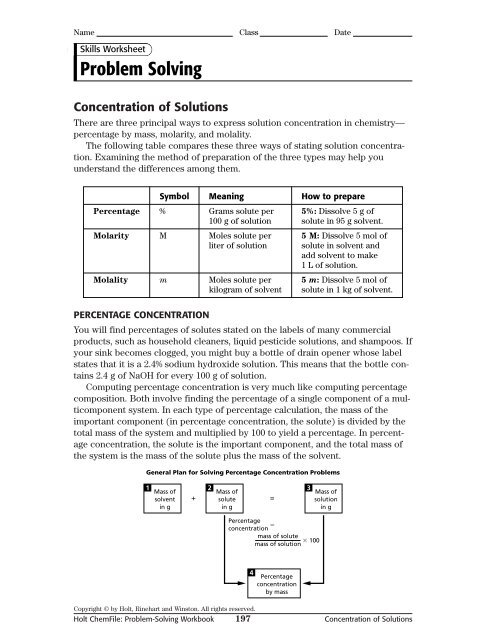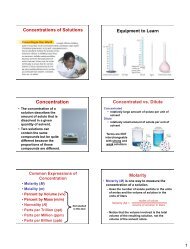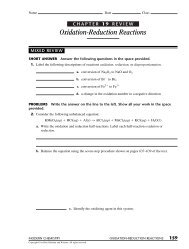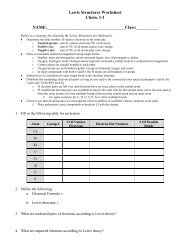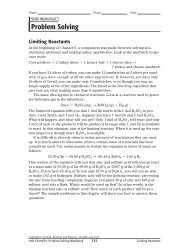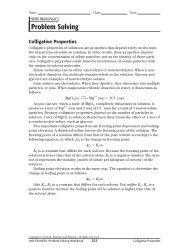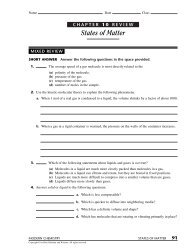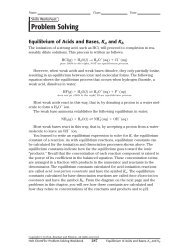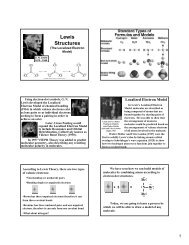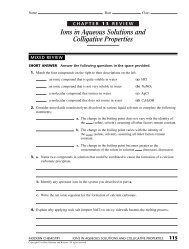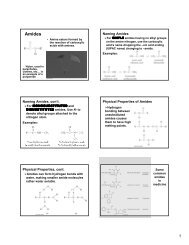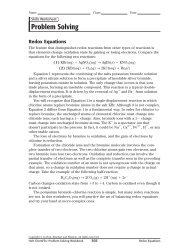Concentration of Solutions
Concentration of Solutions
Concentration of Solutions
You also want an ePaper? Increase the reach of your titles
YUMPU automatically turns print PDFs into web optimized ePapers that Google loves.
Name Class Date<br />
Skills Worksheet<br />
Problem Solving<br />
<strong>Concentration</strong> <strong>of</strong> <strong>Solutions</strong><br />
There are three principal ways to express solution concentration in chemistry—<br />
percentage by mass, molarity, and molality.<br />
The following table compares these three ways <strong>of</strong> stating solution concentration.<br />
Examining the method <strong>of</strong> preparation <strong>of</strong> the three types may help you<br />
understand the differences among them.<br />
Symbol Meaning How to prepare<br />
Percentage %<br />
Grams solute per 5%: Dissolve 5 g <strong>of</strong><br />
100 g <strong>of</strong> solution solute in 95 g solvent.<br />
Molarity<br />
Molality<br />
M<br />
m<br />
Moles solute per<br />
liter <strong>of</strong> solution<br />
Moles solute per<br />
kilogram <strong>of</strong> solvent<br />
5 M: Dissolve 5 mol <strong>of</strong><br />
solute in solvent and<br />
add solvent to make<br />
1 L <strong>of</strong> solution.<br />
5 m: Dissolve 5 mol <strong>of</strong><br />
solute in 1 kg <strong>of</strong> solvent.<br />
PERCENTAGE CONCENTRATION<br />
You will find percentages <strong>of</strong> solutes stated on the labels <strong>of</strong> many commercial<br />
products, such as household cleaners, liquid pesticide solutions, and shampoos. If<br />
your sink becomes clogged, you might buy a bottle <strong>of</strong> drain opener whose label<br />
states that it is a 2.4% sodium hydroxide solution. This means that the bottle contains<br />
2.4 g <strong>of</strong> NaOH for every 100 g <strong>of</strong> solution.<br />
Computing percentage concentration is very much like computing percentage<br />
composition. Both involve finding the percentage <strong>of</strong> a single component <strong>of</strong> a multicomponent<br />
system. In each type <strong>of</strong> percentage calculation, the mass <strong>of</strong> the<br />
important component (in percentage concentration, the solute) is divided by the<br />
total mass <strong>of</strong> the system and multiplied by 100 to yield a percentage. In percentage<br />
concentration, the solute is the important component, and the total mass <strong>of</strong><br />
the system is the mass <strong>of</strong> the solute plus the mass <strong>of</strong> the solvent.<br />
General Plan for Solving Percentage <strong>Concentration</strong> Problems<br />
1<br />
Mass <strong>of</strong><br />
solvent<br />
in g<br />
<br />
2<br />
Mass <strong>of</strong><br />
solute<br />
in g<br />
<br />
3<br />
Mass <strong>of</strong><br />
solution<br />
in g<br />
Percentage<br />
concentration <br />
mass <strong>of</strong> solute<br />
100<br />
mass <strong>of</strong> solution<br />
Copyright © by Holt, Rinehart and Winston. All rights reserved.<br />
4<br />
Percentage<br />
concentration<br />
by mass<br />
Holt ChemFile: Problem-Solving Workbook 197 <strong>Concentration</strong> <strong>of</strong> <strong>Solutions</strong>
Name Class Date<br />
Problem Solving continued<br />
Sample Problem 1<br />
What is the percentage by mass <strong>of</strong> a solution made by dissolving 0.49 g <strong>of</strong><br />
potassium sulfate in 12.70 g <strong>of</strong> water?<br />
Solution<br />
ANALYZE<br />
What is given in the problem?<br />
What are you asked to find?<br />
the mass <strong>of</strong> solvent, and the mass <strong>of</strong> solute,<br />
K 2 SO 4<br />
the concentration <strong>of</strong> the solution expressed as<br />
a percentage by mass<br />
Items<br />
Mass <strong>of</strong> solvent<br />
Data<br />
12.70 g H 2 O<br />
PLAN<br />
What step is needed to calculate the concentration <strong>of</strong> the solution as a percentage<br />
by mass?<br />
Divide the mass <strong>of</strong> solute by the mass <strong>of</strong> the solution and multiply by 100.<br />
1<br />
Mass <strong>of</strong> water in g <br />
Mass <strong>of</strong> solute 0.49 g K 2 SO 4<br />
<strong>Concentration</strong> (% by mass) ? %<br />
2<br />
Mass <strong>of</strong> K 2<br />
SO 4<br />
in g<br />
<br />
3<br />
Mass <strong>of</strong> K 2<br />
SO 4<br />
solution in g<br />
percentage solute mass<br />
concentration<br />
100<br />
solution mass<br />
4<br />
Percentage<br />
K 2<br />
SO 4<br />
by mass<br />
given<br />
g K 2<br />
SO 4 100<br />
percentage concentration g K2 SO 4<br />
g H 2<br />
O<br />
given<br />
given<br />
COMPUTE<br />
0.49 g K<br />
percentage concentration 2 SO<br />
4<br />
100 3.7% K 2 SO 4<br />
0.49 g K 2 SO 4 12.70 g H 2 O<br />
EVALUATE<br />
Are the units correct?<br />
Yes; percentage K 2 SO 4 was required.<br />
Is the number <strong>of</strong> significant figures correct?<br />
Yes; the number <strong>of</strong> significant figures is correct because the data had a minimum<br />
<strong>of</strong> two significant figures.<br />
Copyright © by Holt, Rinehart and Winston. All rights reserved.<br />
Holt ChemFile: Problem-Solving Workbook 198 <strong>Concentration</strong> <strong>of</strong> <strong>Solutions</strong>
Name Class Date<br />
Problem Solving continued<br />
Is the answer reasonable?<br />
Yes; the computation can be approximated as 0.5/13 100 3.8%.<br />
Practice<br />
1. What is the percentage concentration <strong>of</strong> 75.0 g <strong>of</strong> ethanol dissolved in 500.0 g<br />
<strong>of</strong> water? ans: 13.0% ethanol<br />
2. A chemist dissolves 3.50 g <strong>of</strong> potassium iodate and 6.23 g <strong>of</strong> potassium<br />
hydroxide in 805.05 g <strong>of</strong> water. What is the percentage concentration <strong>of</strong> each<br />
solute in the solution? ans: 0.430% KIO 3 , 0.765% KOH<br />
3. A student wants to make a 5.00% solution <strong>of</strong> rubidium chloride using 0.377 g<br />
<strong>of</strong> the substance. What mass <strong>of</strong> water will be needed to make the solution?<br />
ans: 7.16 g H 2 O<br />
4. What mass <strong>of</strong> lithium nitrate would have to be dissolved in 30.0 g <strong>of</strong> water in<br />
order to make an 18.0% solution? ans: 6.59 g LiNO 3<br />
Copyright © by Holt, Rinehart and Winston. All rights reserved.<br />
Holt ChemFile: Problem-Solving Workbook 199 <strong>Concentration</strong> <strong>of</strong> <strong>Solutions</strong>
Name Class Date<br />
Problem Solving continued<br />
MOLARITY<br />
Molarity is the most common way to express concentration in chemistry. Molarity<br />
is the number <strong>of</strong> moles <strong>of</strong> solute per liter <strong>of</strong> solution and is given as a number followed<br />
by a capital M. A 2 M solution <strong>of</strong> nitric acid contains 2 mol <strong>of</strong> HNO 3 per<br />
liter <strong>of</strong> solution. As you know, substances react in mole ratios. Knowing the<br />
molar concentration <strong>of</strong> a solution allows you to measure a number <strong>of</strong> moles <strong>of</strong> a<br />
dissolved substance by measuring the volume <strong>of</strong> solution.<br />
General Plan for Solving Molarity Problems<br />
1<br />
Mass <strong>of</strong><br />
solute<br />
in g<br />
Convert<br />
using the<br />
molar mass<br />
<strong>of</strong> the solute.<br />
2<br />
Amount<br />
<strong>of</strong> solute<br />
in mol<br />
M <br />
4<br />
moles solute<br />
liter solution<br />
Molar<br />
concentration,<br />
M<br />
3<br />
Volume<br />
<strong>of</strong> solution<br />
in L<br />
Copyright © by Holt, Rinehart and Winston. All rights reserved.<br />
Holt ChemFile: Problem-Solving Workbook 200 <strong>Concentration</strong> <strong>of</strong> <strong>Solutions</strong>
Name Class Date<br />
Problem Solving continued<br />
Sample Problem 2<br />
What is the molarity <strong>of</strong> a solution prepared by dissolving 37.94 g <strong>of</strong><br />
potassium hydroxide in some water and then diluting the solution to a<br />
volume <strong>of</strong> 500.00 mL?<br />
Solution<br />
ANALYZE<br />
What is given in the problem?<br />
What are you asked to find?<br />
the mass <strong>of</strong> the solute, KOH, and the final volume<br />
<strong>of</strong> the solution<br />
the concentration <strong>of</strong> the solution expressed as<br />
molarity<br />
Items<br />
Mass <strong>of</strong> solute<br />
Moles <strong>of</strong> solute<br />
Molar mass <strong>of</strong> solute*<br />
Volume <strong>of</strong> solution<br />
<strong>Concentration</strong> (molarity)<br />
Data<br />
37.94 g KOH<br />
? mol KOH<br />
56.11 g/mol<br />
500.00 mL<br />
? M<br />
* determined from the periodic table<br />
PLAN<br />
What steps are needed to calculate the concentration <strong>of</strong> the solution as molarity?<br />
Determine the amount in moles <strong>of</strong> solute; calculate the moles per liter <strong>of</strong> solution.<br />
1<br />
Mass <strong>of</strong> KOH<br />
in g<br />
multiply by the<br />
inverted molar<br />
mass <strong>of</strong> KOH<br />
Volume <strong>of</strong> KOH<br />
solution in mL<br />
multiply by the<br />
conversion factor<br />
1 L<br />
1000 mL<br />
2<br />
Amount <strong>of</strong> KOH<br />
in mol<br />
moles solute<br />
M liter solution<br />
4<br />
Molarity <strong>of</strong> KOH<br />
solution<br />
3<br />
Volume <strong>of</strong> KOH<br />
solution in L<br />
1<br />
molar mass <strong>of</strong> KOH<br />
given 1 mol KOH mol KOH<br />
g KOH 56.11 g KOH<br />
Copyright © by Holt, Rinehart and Winston. All rights reserved.<br />
Holt ChemFile: Problem-Solving Workbook 201 <strong>Concentration</strong> <strong>of</strong> <strong>Solutions</strong>
Name Class Date<br />
Problem Solving continued<br />
given 1 L<br />
mL solution L solution<br />
1000 mL<br />
calculated above<br />
mol KOH M solution<br />
L solution<br />
calculated above<br />
COMPUTE<br />
37.94 g KOH <br />
1 mol KOH<br />
0.6762 mol KOH<br />
56.11 g KOH<br />
1 L<br />
500.00 mL solution 0.500 00 L solution<br />
100 0mL<br />
0.6762 mol KOH<br />
1.352 M<br />
0.500 00 L solution<br />
EVALUATE<br />
Are the units correct?<br />
Yes; units canceled to give moles KOH per liter <strong>of</strong> solution.<br />
Is the number <strong>of</strong> significant figures correct?<br />
Yes; the number <strong>of</strong> significant figures is correct because the data had a minimum<br />
<strong>of</strong> four significant figures.<br />
Is the answer reasonable?<br />
Yes; note that 0.6762 mol is approximately 2/3 mol and 0.500 00 L is 1/2 L. Thus,<br />
the calculation can be estimated as (2/3)/(1/2) 4/3, which is very close to the<br />
result.<br />
Practice<br />
1. Determine the molarity <strong>of</strong> a solution prepared by dissolving 141.6 g <strong>of</strong> citric<br />
acid, C 3 H 5 O(COOH) 3 , in water and then diluting the resulting solution to<br />
3500.0 mL. ans: 0.2106 M<br />
Copyright © by Holt, Rinehart and Winston. All rights reserved.<br />
Holt ChemFile: Problem-Solving Workbook 202 <strong>Concentration</strong> <strong>of</strong> <strong>Solutions</strong>
Name Class Date<br />
Problem Solving continued<br />
2. What is the molarity <strong>of</strong> a salt solution made by dissolving 280.0 mg <strong>of</strong> NaCl in<br />
2.00 mL <strong>of</strong> water? Assume the final volume is the same as the volume <strong>of</strong> the<br />
water. ans: 2.40 M<br />
3. What is the molarity <strong>of</strong> a solution that contains 390.0 g <strong>of</strong> acetic acid,<br />
CH 3 COOH, dissolved in enough acetone to make 1000.0 mL <strong>of</strong> solution?<br />
ans: 6.494 M<br />
Copyright © by Holt, Rinehart and Winston. All rights reserved.<br />
Holt ChemFile: Problem-Solving Workbook 203 <strong>Concentration</strong> <strong>of</strong> <strong>Solutions</strong>
Name Class Date<br />
Problem Solving continued<br />
Sample Problem 3<br />
An analytical chemist wants to make 750.0 mL <strong>of</strong> a 6.00 M solution <strong>of</strong><br />
sodium hydroxide. What mass <strong>of</strong> NaOH will the chemist need to make this<br />
solution?<br />
Solution<br />
ANALYZE<br />
What is given in the problem?<br />
What are you asked to find?<br />
the identity <strong>of</strong> the solute, the total volume <strong>of</strong><br />
solution, and the molarity <strong>of</strong> the solution<br />
the mass <strong>of</strong> solute to dissolve<br />
Items<br />
Mass <strong>of</strong> solute<br />
Molar mass <strong>of</strong> solute<br />
Moles <strong>of</strong> solute<br />
Volume <strong>of</strong> solution<br />
<strong>Concentration</strong> (molarity)<br />
Data<br />
? g NaOH<br />
40.00 g/mol<br />
? mol NaOH<br />
750.0 mL<br />
6.00 M<br />
PLAN<br />
What steps are needed to calculate the mass <strong>of</strong> solute needed?<br />
Determine the amount in moles needed for the solution required, and convert to<br />
grams by multiplying by the molar mass <strong>of</strong> the solute.<br />
COMPUTE<br />
Molarity <strong>of</strong><br />
NaOH solution<br />
<br />
Volume <strong>of</strong> NaOH<br />
solution in L<br />
<br />
Amount <strong>of</strong> NaOH<br />
in mol<br />
multiply by the<br />
conversion<br />
1 L<br />
factor<br />
1000 mL<br />
Volume <strong>of</strong><br />
NaOH solution in mL<br />
given 1 L<br />
mL solution L solution<br />
1000 mL<br />
multiply by the<br />
molar mass <strong>of</strong><br />
NaOH<br />
Mass <strong>of</strong> NaOH<br />
in g<br />
given<br />
mol NaOH<br />
L solution<br />
calculated<br />
molar mass <strong>of</strong> NaOH<br />
above 40.00 g NaOH L solution g NaOH<br />
1 mol NaOH<br />
1 L<br />
750.0 mL<br />
solution 100 0<br />
mL <br />
0.7500 L solution<br />
Copyright © by Holt, Rinehart and Winston. All rights reserved.<br />
Holt ChemFile: Problem-Solving Workbook 204 <strong>Concentration</strong> <strong>of</strong> <strong>Solutions</strong>
Name Class Date<br />
Problem Solving continued<br />
EVALUATE<br />
Are the units correct?<br />
Yes; units canceled to give grams <strong>of</strong> NaOH.<br />
Is the number <strong>of</strong> significant figures correct?<br />
Yes; the number <strong>of</strong> significant figures is correct because the data had a minimum<br />
<strong>of</strong> three significant figures.<br />
Is the answer reasonable?<br />
Yes; the calculation can be estimated as (3/4) (6)(40) (3/4) 240 180.<br />
Practice<br />
6.00 mol NaOH<br />
L solution<br />
0.7500 L solution <br />
40.00 g NaOH<br />
1 mol NaOH<br />
180. g NaOH<br />
1. What mass <strong>of</strong> glucose, C 6 H 12 O 6 , would be required to prepare 5.000 10 3 L <strong>of</strong><br />
a 0.215 M solution? ans: 1.94 10 5 g<br />
2. What mass <strong>of</strong> magnesium bromide would be required to prepare 720. mL <strong>of</strong> a<br />
0.0939 M aqueous solution? ans: 12.4 g<br />
3. What mass <strong>of</strong> ammonium chloride is dissolved in 300. mL <strong>of</strong> a 0.875 M solution?<br />
ans: 14.0 g<br />
Copyright © by Holt, Rinehart and Winston. All rights reserved.<br />
Holt ChemFile: Problem-Solving Workbook 205 <strong>Concentration</strong> <strong>of</strong> <strong>Solutions</strong>
Name Class Date<br />
Problem Solving continued<br />
MOLALITY<br />
Molality is the amount in moles <strong>of</strong> solute per kilogram <strong>of</strong> solvent and is given by<br />
a number followed by an italic lowercase m. A 5 m aqueous solution <strong>of</strong> glucose<br />
contains 5 mol <strong>of</strong> C 6 H 12 O 6 per kilogram <strong>of</strong> water. Molal concentration is important<br />
primarily in working with colligative properties <strong>of</strong> solutions.<br />
General Plan for Solving Molality Problems<br />
1<br />
Mass <strong>of</strong><br />
solute<br />
in g<br />
3<br />
Mass <strong>of</strong><br />
solvent<br />
in g<br />
Convert<br />
using the<br />
molar mass<br />
<strong>of</strong> the solute.<br />
Convert<br />
using the<br />
equation<br />
1 kg 1000 g.<br />
2<br />
Amount<br />
<strong>of</strong> solute<br />
in mol<br />
m <br />
mol solute<br />
kg solvent<br />
4<br />
Mass <strong>of</strong><br />
solvent in<br />
kg<br />
5<br />
Molal<br />
concentration,<br />
m<br />
Copyright © by Holt, Rinehart and Winston. All rights reserved.<br />
Holt ChemFile: Problem-Solving Workbook 206 <strong>Concentration</strong> <strong>of</strong> <strong>Solutions</strong>
Name Class Date<br />
Problem Solving continued<br />
Sample Problem 4<br />
Determine the molal concentration <strong>of</strong> a solution containing 81.3 g <strong>of</strong><br />
ethylene glycol, HOCH 2 CH 2 OH, dissolved in 166 g <strong>of</strong> water.<br />
Solution<br />
ANALYZE<br />
What is given in the problem?<br />
What are you asked to find?<br />
the mass <strong>of</strong> ethylene glycol dissolved, and the<br />
mass <strong>of</strong> the solvent, water<br />
the molal concentration <strong>of</strong> the solution<br />
Items<br />
Mass <strong>of</strong> solute<br />
Molar mass <strong>of</strong> solute<br />
Moles <strong>of</strong> solute<br />
Mass <strong>of</strong> solvent<br />
<strong>Concentration</strong> (molality)<br />
Data<br />
81.3 g ethylene glycol<br />
62.08 g/mol ethylene glycol<br />
? mol ethylene glycol<br />
166 g H 2 O<br />
? m<br />
PLAN<br />
What steps are needed to calculate the molal concentration <strong>of</strong> the ethylene glycol<br />
solution?<br />
Determine the amount <strong>of</strong> solute in moles and the mass <strong>of</strong> solvent in kilograms;<br />
calculate the moles <strong>of</strong> solute per kilogram <strong>of</strong> solvent.<br />
1<br />
Mass <strong>of</strong> C 2<br />
H 6<br />
O 2<br />
in g<br />
multiply by the<br />
inverted molar<br />
mass <strong>of</strong> C 2<br />
H 6<br />
O 2<br />
2<br />
Amount <strong>of</strong> C 2<br />
H 6<br />
O 2<br />
in mol<br />
moles C 2<br />
H 6<br />
O<br />
m <br />
2<br />
kg H 2<br />
O<br />
5<br />
Molality <strong>of</strong> C 2<br />
H 6<br />
O 2<br />
solution<br />
3<br />
Mass <strong>of</strong> H 2<br />
O in g<br />
multiply by the<br />
conversion factor<br />
1 kg<br />
1000 g<br />
4<br />
Mass <strong>of</strong> H 2<br />
O in kg<br />
1<br />
molar mass <strong>of</strong> C 2<br />
H 6<br />
O 2<br />
given 1 mol C 2<br />
H 6<br />
O 2 mol C2 H 6<br />
O 2<br />
g C 2<br />
H 6<br />
O 2<br />
62.08 g C2 H 6<br />
O 2<br />
given 1 kg<br />
g H 2<br />
O kg H2 O<br />
1000 g<br />
calculated above<br />
mol C 2<br />
H 6<br />
O 2<br />
m C 2<br />
H 6<br />
O 2<br />
solution<br />
kg H 2<br />
O<br />
calculated above<br />
Copyright © by Holt, Rinehart and Winston. All rights reserved.<br />
Holt ChemFile: Problem-Solving Workbook 207 <strong>Concentration</strong> <strong>of</strong> <strong>Solutions</strong>s
Name Class Date<br />
Problem Solving continued<br />
COMPUTE<br />
1 kg<br />
166 g H 2 O 0.166 kg H 2 O<br />
1 000<br />
g<br />
1.31<br />
mol<br />
C<br />
2 6O 2<br />
7.89 m<br />
0.166<br />
kg<br />
HH<br />
2O<br />
EVALUATE<br />
Are the units correct?<br />
Yes; units canceled to give moles C 2 H 6 O 2 per kilogram <strong>of</strong> solvent.<br />
Is the number <strong>of</strong> significant figures correct?<br />
Yes; the number <strong>of</strong> significant figures is correct because the data had a minimum<br />
<strong>of</strong> three significant figures.<br />
Is the answer reasonable?<br />
Yes; because 1.31 mol is approximately 4/3 mol and 0.166 kg is approximately 1/6<br />
kg, the calculation can be estimated as (4/3)/(1/6) 24/3 8, which is very<br />
close to the result.<br />
Practice<br />
81.3 g C 2 H 6 O 2 1 mol C 2H 6 O 2<br />
62.08 g C 2 H 6 O 2<br />
1.31 mol C 2 H 6 O 2<br />
1. Determine the molality <strong>of</strong> a solution <strong>of</strong> 560 g <strong>of</strong> acetone, CH 3 COCH 3 , in 620 g<br />
<strong>of</strong> water. ans: 16 m<br />
2. What is the molality <strong>of</strong> a solution <strong>of</strong> 12.9 g <strong>of</strong> fructose, C 6 H 12 O 6 , in 31.0 g <strong>of</strong><br />
water? ans: 2.31 m<br />
3. How many moles <strong>of</strong> 2-butanol, CH 3 CHOHCH 2 CH 3 , must be dissolved in 125 g<br />
<strong>of</strong> ethanol in order to produce a 12.0 m 2-butanol solution? What mass <strong>of</strong> 2-<br />
butanol is this? ans: 1.50 mol 2-butanol, 111 g 2-butanol<br />
Copyright © by Holt, Rinehart and Winston. All rights reserved.<br />
Holt ChemFile: Problem-Solving Workbook 208 <strong>Concentration</strong> <strong>of</strong> <strong>Solutions</strong>
Name Class Date<br />
Problem Solving continued<br />
Additional Problems<br />
1. Complete the table below by determining the missing quantity in each example.<br />
All solutions are aqueous. Any quantity that is not applicable to a given<br />
solution is marked NA.<br />
Quantity Quantity<br />
Mass <strong>of</strong> <strong>of</strong> solution <strong>of</strong> solvent<br />
Solution made solute used made used<br />
a. 12.0% KMnO 4 ? g KMnO 4 500.0 g ? g H 2 O<br />
b. 0.60 M BaCl 2 ? g BaCl 2 1.750 L NA<br />
c. 6.20 m glycerol, ? g glycerol NA 800.0 g H 2 O<br />
HOCH 2 CHOHCH 2 OH<br />
d. ? M K 2 Cr 2 O 7 12.27 g K 2 Cr 2 O 7 650. mL NA<br />
e. ? m CaCl 2 288 g CaCl 2 NA 2.04 kg H 2 O<br />
f. 0.160 M NaCl ? g NaCl 25.0 mL NA<br />
g. 2.00 m glucose, ? g glucose ? g solution 1.50 kg H 2 O<br />
C 6 H 12 O 6<br />
2. How many moles <strong>of</strong> H 2 SO 4 are in 2.50 L <strong>of</strong> a 4.25 M aqueous solution?<br />
3. Determine the molal concentration <strong>of</strong> 71.5 g <strong>of</strong> linoleic acid, C 18 H 32 O 2 , in<br />
525 g <strong>of</strong> hexane, C 6 H 14 .<br />
4. You have a solution that is 16.2% sodium thiosulfate, Na 2 S 2 O 3 , by mass.<br />
a. What mass <strong>of</strong> sodium thiosulfate is in 80.0 g <strong>of</strong> solution?<br />
b. How many moles <strong>of</strong> sodium thiosulfate are in 80.0 g <strong>of</strong> solution?<br />
c. If 80.0 g <strong>of</strong> the sodium thiosulfate solution is diluted to 250.0 mL with<br />
water, what is the molarity <strong>of</strong> the resulting solution?<br />
5. What mass <strong>of</strong> anhydrous cobalt(II) chloride would be needed in order to<br />
make 650.00 mL <strong>of</strong> a 4.00 M cobalt(II) chloride solution?<br />
6. A student wants to make a 0.150 M aqueous solution <strong>of</strong> silver nitrate, AgNO 3<br />
and has a bottle containing 11.27 g <strong>of</strong> silver nitrate. What should be the final<br />
volume <strong>of</strong> the solution?<br />
7. What mass <strong>of</strong> urea, NH 2 CONH 2 , must be dissolved in 2250 g <strong>of</strong> water in order<br />
to prepare a 1.50 m solution?<br />
8. What mass <strong>of</strong> barium nitrate is dissolved in 21.29 mL <strong>of</strong> a 3.38 M solution?<br />
9. Describe what you would do to prepare 100.0 g <strong>of</strong> a 3.5% solution <strong>of</strong> ammonium<br />
sulfate in water.<br />
10. What mass <strong>of</strong> anhydrous calcium chloride should be dissolved in 590.0 g <strong>of</strong><br />
water in order to produce a 0.82 m solution?<br />
11. How many moles <strong>of</strong> ammonia are in 0.250 L <strong>of</strong> a 5.00 M aqueous ammonia<br />
solution? If this solution were diluted to 1.000 L, what would be the molarity<br />
<strong>of</strong> the resulting solution?<br />
Copyright © by Holt, Rinehart and Winston. All rights reserved.<br />
Holt ChemFile: Problem-Solving Workbook 209 <strong>Concentration</strong> <strong>of</strong> <strong>Solutions</strong>
Name Class Date<br />
Problem Solving continued<br />
12. What is the molar mass <strong>of</strong> a solute if 62.0 g <strong>of</strong> the solute in 125 g <strong>of</strong> water<br />
produce a 5.3 m solution?<br />
13. A saline solution is 0.9% NaCl. What masses <strong>of</strong> NaCl and water would be<br />
required to prepare 50. L <strong>of</strong> this saline solution? Assume that the density <strong>of</strong><br />
water is 1.000 g/mL and that the NaCl does not add to the volume <strong>of</strong> the<br />
solution.<br />
14. A student weighs an empty beaker on a balance and finds its mass to be<br />
68.60 g. The student weighs the beaker again after adding water and finds the<br />
new mass to be 115.12 g. A mass <strong>of</strong> 4.08 g <strong>of</strong> glucose is then dissolved in the<br />
water. What is the percentage concentration <strong>of</strong> glucose in the solution?<br />
15. The density <strong>of</strong> ethyl acetate at 20°C is 0.902 g/mL. What volume <strong>of</strong> ethyl<br />
acetate at 20°C would be required to prepare a 2.0% solution <strong>of</strong> cellulose<br />
nitrate using 25 g <strong>of</strong> cellulose nitrate?<br />
16. Aqueous cadmium chloride reacts with sodium sulfide to produce brightyellow<br />
cadmium sulfide. Write the balanced equation for this reaction and<br />
answer the following questions.<br />
a. How many moles <strong>of</strong> CdCl 2 are in 50.00 mL <strong>of</strong> a 3.91 M solution?<br />
b. If the solution in (a) reacted with excess sodium sulfide, how many moles<br />
<strong>of</strong> CdS would be formed?<br />
c. What mass <strong>of</strong> CdS would be formed?<br />
17. What mass <strong>of</strong> H 2 SO 4 is contained in 60.00 mL <strong>of</strong> a 5.85 M solution <strong>of</strong> sulfuric<br />
acid?<br />
18. A truck carrying 22.5 kL <strong>of</strong> 6.83 M aqueous hydrochloric acid used to clean<br />
brick and masonry has overturned. The authorities plan to neutralize the acid<br />
with sodium carbonate. How many moles <strong>of</strong> HCl will have to be neutralized?<br />
19. A chemist wants to produce 12.00 g <strong>of</strong> barium sulfate by reacting a 0.600 M<br />
BaCl 2 solution with excess H 2 SO 4 , as shown in the reaction below. What<br />
volume <strong>of</strong> the BaCl 2 solution should be used?<br />
BaCl 2 H 2 SO 4 → BaSO 4 2HCl<br />
20. Many substances are hydrates. Whenever you make a solution, it is important<br />
to know whether or not the solute you are using is a hydrate and, if it is a<br />
hydrate, how many molecules <strong>of</strong> water are present per formula unit <strong>of</strong> the<br />
substance. This water must be taken into account when weighing out the<br />
solute. Something else to remember when making aqueous solutions from<br />
hydrates is that once the hydrate is dissolved, the water <strong>of</strong> hydration is considered<br />
to be part <strong>of</strong> the solvent. A common hydrate used in the chemistry<br />
laboratory is copper sulfate pentahydrate, CuSO 4 5H 2 O. Describe how you<br />
would make each <strong>of</strong> the following solutions using CuSO 4 5H 2 O. Specify<br />
masses and volumes as needed.<br />
a. 100. g <strong>of</strong> a 6.00% solution <strong>of</strong> CuSO 4<br />
b. 1.00 L <strong>of</strong> a 0.800 M solution <strong>of</strong> CuSO 4<br />
c. a 3.5 m solution <strong>of</strong> CuSO 4 in 1.0 kg <strong>of</strong> water<br />
Copyright © by Holt, Rinehart and Winston. All rights reserved.<br />
Holt ChemFile: Problem-Solving Workbook 210 <strong>Concentration</strong> <strong>of</strong> <strong>Solutions</strong>
Name Class Date<br />
Problem Solving continued<br />
21. What mass <strong>of</strong> calcium chloride hexahydrate is required in order to make 700.0<br />
mL <strong>of</strong> a 2.50 M solution?<br />
22. What mass <strong>of</strong> the amino acid arginine, C 6 H 14 N 4 O 2 , would be required to make<br />
1.250 L <strong>of</strong> a 0.00205 M solution?<br />
23. How much water would you have to add to 2.402 kg <strong>of</strong> nickel(II) sulfate<br />
hexahydrate in order to prepare a 25.00% solution?<br />
24. What mass <strong>of</strong> potassium aluminum sulfate dodecahydrate, KAl(SO 4 ) 2 12H 2 O,<br />
would be needed to prepare 35.00 g <strong>of</strong> a 15.00% KAl(SO 4 ) 2 solution? What<br />
mass <strong>of</strong> water would be added to make this solution?<br />
Copyright © by Holt, Rinehart and Winston. All rights reserved.<br />
Holt ChemFile: Problem-Solving Workbook 211 <strong>Concentration</strong> <strong>of</strong> <strong>Solutions</strong>


